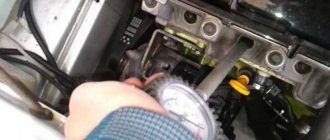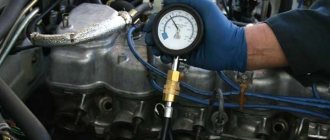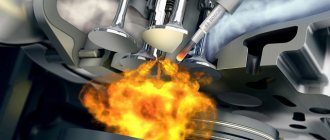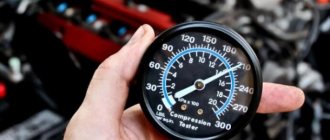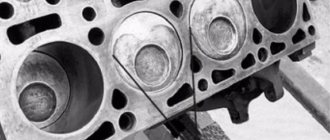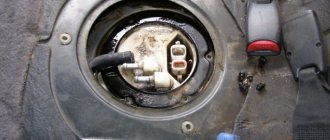The first signs of engine wear are difficult cold starting and increased oil consumption (over 150 ml per 1 thousand kilometers). When such symptoms appear, a compression test is performed in the engine cylinders, which helps to more accurately determine the technical condition of the cylinder-piston and valve group. To carry out such diagnostics, it is not necessary to go to a car service: it is enough to get a special pressure gauge and understand what the compression should be in a working power unit.
Criteria and norms of compression in cylinders
There is a point of view among owners of innovative vehicles that the pressure of a heated internal combustion engine can be from eight to ten atmospheres.
The machines use engines of different configurations, depending on the number of valves and camshafts, the shape of the intake manifold, and the built-in connecting rod-piston system. According to this, its specific level of pressure is determined - this is the ratio of the capacity of the cylinder to the capacity of the combustion chamber.
The higher the compression level, the higher the compression number. For engines running on gasoline, the compression indicator lies in the range of eight to twelve units, which is indicated in the registration certificate of a particular vehicle.
In theory, it is not difficult to calculate what the pressure in the cylinders should be for a particular engine. It is necessary to multiply the compression level by a factor of 1.3.
The concept of compression
Compression is the maximum pressure for the combustion chamber that is created by the piston inside the cylinder when it reaches top dead center (TDC) on the compression stroke.
Measurements are needed to check the tightness of the chamber. In this case, the tightness of the assembly depends on the current state of several important elements:
- pistons;
- compression rings;
- valve with seat;
- cylinder head gaskets;
- thermal gap in the timing belt.
There is actually nothing fundamentally difficult about measuring compression in an engine. After checking, you can understand what faults there are in the engine and how long the internal combustion engine will last in this condition.
Considering the information content provided by compression measurements, such a diagnostic procedure has become very common and in demand.
Despite the general principle of operation of internal combustion engines, the design of engines on different cars differs. Hence the different compression ratios.
To determine the optimal parameters of a particular machine, you need to look at the technical documentation. It is these numbers that you should rely on when taking measurements and comparing them with the optimal ones for your car.
Take into account one more important point. Compression measurements on engines that have been in use for a long time do not necessarily have to strictly comply with the standard. Due to gradual wear, compression drops. But as soon as the drop goes below the limit value, this is a signal about wear of the engine CPG. Therefore, the engine will need a major overhaul.
Compression differences between cylinders may vary slightly. But the deviation should not exceed 1 kgf/cm2.
In other words, it is not always necessary to strive for ideal values. The main thing is that the engine is in good working order. Error is always allowed.
How to measure compression in an engine
The procedure is carried out with a special device - a compression gauge, which includes the following components:
- Pressure gauge with thread;
- A metal pipe or soft hose with a built-in shut-off valve and an air release button;
- A part for screwing into a cylinder, fed by adapters for other threads or a rubber cone.
The pressure gauge is built into the tube (flexible hose), with a thread on the opposite side. The check valve is necessary to determine the pressure gauge readings, since during testing the piston gains pressure within a couple of crankshaft rotations (about ten).
To control gasoline and diesel internal combustion engines, pressure gauges with different measuring scales can be used. If for engines operating on gasoline a device provided for twenty to twenty-five Bars is sufficient, then to study a diesel engine you will need a scale of at least fifty Bars.
How to measure compression in an engine?
For an initial general assessment of compression in the cylinders of a gasoline internal combustion engine, the following rules must be followed:
- Heated to the optimal temperature;
- Spark plugs are turned out from all cylinders;
- The fuel supply is turned off (on injection engines you need to turn off the crankshaft position converter, on carburetor engines you need to turn off the fuel intake from the fuel pump);
- The generator is fully charged or additionally connected to the starting unit;
- The starter is in working order;
- The clutch pedal is depressed;
- Throttle valve is open;
- The measuring modes for all cylinders are identical in terms of the speed of cranking by the starter (or the number of strokes).
What does compression depend on?
The cylinder during compression/combustion strokes is a closed system consisting of:
- piston;
- piston rings;
- cylinder walls;
- cylinder head gaskets;
- valves
Damage to any of the elements that form this closed system leads to a decrease in pressure. If the piston is cracked, burned out or otherwise damaged, exhaust gases will leak, which will negatively affect the power and service life of the engine.
Most often, pressure drops due to worn or coked rings.
Wear of the rings occurs due to friction against the walls of the combustion chambers. Exceeding the engine temperature leads to an increase in the size of the rings, when their locking ceases to cope with its duties, they leave scratches on the cylinders, destroying the honing. Incorrect composition of the air-fuel mixture, malfunction of the ignition or fuel injection systems lead to the fact that the rings are covered with a layer of unburned resins, due to which they lose mobility and the lock stops working. The ring freezes to its maximum size, because the lock is clogged with resin, so it cannot shrink. When starting a cold engine, the friction between the ring and the cylinder walls is too great, causing damage.
Formation of soot and varnish deposits
A non-optimal composition of the air-fuel mixture, an incorrectly set ignition or fuel injection timing, and incorrect valve timing lead to the air-fuel mixture burning as it passes through the valves. Because of this, the ground surface of the valves burns and loses its tightness, which leads to a decrease in pressure, and then to a further increase in damage. When overheating, driving for a long time at low speeds and high gears, during a sharp start or long-term operation of the engine in a power mode close to maximum, the likelihood of burnout or breakdown of the cylinder head gasket increases. If damage to the gasket connects the cylinder and the oil or cooling channel, then hot gases enter the corresponding system, sharply reduce the life of the antifreeze or oil, and the coolant and oil impair fuel combustion in the cylinders.
Engine compression and diagnostics
Checking engine compression, as well as some indirect signs, allows you to accurately determine not only engine damage, but also determine what reason led to this. The measurement must be made on a cold engine, which will require a device called a “compressometer”. This device is sold at any auto store.
If the measurement shows a difference in compression in the cylinders of more than 0.5 atmospheres, the rings need to be replaced. If the measurement showed a decrease in compression in all cylinders by 0.5 atmospheres also against the background of a drop in engine power, an increase in fuel consumption or gray smoke from the pipe, then the problem is in the rings and valve stem seals. If the measurement shows that the pressure is noticeably lower than it should be (the difference is more than 3 atmospheres), and bluish or white smoke comes from the exhaust pipe, then the alarm indicates a broken cylinder head gasket.
If the measurement showed a drop in compression below 6 atmospheres in one or more (not all) cylinders, the problem may be a burnt-out valve.
If the measurement shows normal compression, and dark (from barely noticeable bluish to thick black) smoke comes out of the exhaust pipe, and the engine power is reduced or fuel consumption has increased, the problem is the incorrect operation of the spark plugs, injectors or carburetor. If the oil level drops, the problem is damage to the oil scraper rings or caps. If you know what caused the compression to drop, you can get away with minor repairs. If, according to the measurement results, the compression in all cylinders is the same and lower than it should be, add 10–15 ml of engine oil to the cylinders. An increase in compression indicates the need to replace the rings.
Compression testing devices
A compression gauge is a unit that contains a pressure gauge with a scale, a pressure relief valve and tips.
The most practical is considered to be an elastic hose with a thread, where a nipple is mounted to prevent air from escaping back out of the device.
The study of compression in internal combustion engine cylinders, which involve spark plug wells in the construction, is carried out by screwing a flexible hose into the threaded slot of the spark plug, which does not allow the passage of compressed air from the leaky contact of rigid tips without threads.
Table: What should be the compression of cars
Car Compression, kg/cm2
| VAZ 2106-07 | 11 |
| VAZ 2109 | 11 |
| VAZ 2110 | 13 |
| Audi A4 (2011-2021) 1.8-2.0/3.0 | 12/12.5 |
| Chevrolet Cruze 1.6/1.8 | 14/13 |
| Chevrolet Lanos 1.5 | 12 |
| Chevrolet Lacetti 1.6/1.8 | 12/12.5 |
| Chevrolet Aveo 1.6 | 13.5 |
| Daewoo Gentra 1.5 | 12.5 |
| Daewoo Matiz 0.8 | 11 |
| Daewoo Nexia 1.5/1.6 | 10.5/11 |
| Ford Focus (2014-2021) 1.0/1.5-2.0 | 12/Too many different options |
| Ford Focus (2011-2014) 1.6/1.6 turbo/2.0 | 13.5/18/14 |
| Honda Civic (2008-2021) 1.8/2.4 | 13/13 |
| Hyundai Elantra (2013-2021) 1.6 | 13 |
| Hyundai Solaris (2011-2021) 1.4/1.6 | 13/13 |
| Kia Sportage (2011-2021) 2.0 | 13 |
| Kia Sportage (2004-2010) 2.0 | 12.5 |
| Kia Cee'd 1.4/1.6 | 13 |
| Kia Rio (2005-2011) | 12.75 |
| Kia Rio (2011-2021) | 12.5-13 |
| Mazda 3 (2010-2021) 1.5/1.6/2.0 | 16/12/16 |
| Mazda 6 (2011-2021) 2.0/2.5 | 16/15 |
| Mitsubishi ASX (2010-2021) 1.6/1.8/2.0 | 13/12.5/12 |
| Mitsubishi Lancer (2007-2021) 1.5/1.6/1.8 | 12.5/12.5/12 |
| Nissan Juke | 12.5 |
| Nissan Qashqai 1.6/2.0 | 12,5/12 |
| Opel Astra 1.4/1.6 | 11/13 |
| Opel Corsa 1.2/1.4 | 12.5/12.5 |
| Toyota RAV4 (2006-2021) 2.0/2.2/2.5 | 12/18/12 |
| Toyota Camry (2009-2021) 2.0/2.4/2.5/3.5 | 11.5/12/12/12,5 |
| Toyota Corolla 1.3/1.6/1.8 | 13.5/12/12 |
| VW Tiguan 1.4/2.0 | 12/12 |
| VW Golf (2009-2021) 1.2/1.4/1.6 | 12/12/12.5 |
| VW Jetta (2010-2021) 1.4/1.6 | 12/12.5 |
Measure the compression in the cylinders yourself
First, you need to determine from the data sheet what the optimal pressure of a gasoline engine is for a given vehicle and calculate the level of accessibility to the spark plugs.
If the input requires disassembly of other engine components (throttle assembly, intake receiver), which prevent their dismantling and there is confidence in their effective disassembly and reassembly, then measurements can be taken.
Motor repair or replacement with a contract one?
In general, any malfunctions that lead to a decrease in compression in the engine cylinders can be eliminated. If the problem lies in the valves/cylinder head, then repair and restoration will cost 300-600 rubles. A liner for one cylinder will cost 80-120 rubles. If the pistons are damaged, they must be replaced. The price of the issue varies greatly depending on the engine and piston manufacturer. For example, for TFSI engines that suffer from oil burns, a Kolbenschmidt piston costs about 200 rubles, and the original costs 650 rubles apiece (these pistons come complete with all rings).
To these amounts should be added the costs of removing and installing the motor, disassembling and reassembling it. As a result, it turns out that the overhaul of the 2-liter TFSI/TSI engine, which is popular in terms of CPG problems, will cost about 3,600 rubles. This is if you change all four pistons. A contract engine costs from 2,500 to 3,000 rubles (plus replacement work, as well as consumables - 1,000 rubles). In this case – and we are talking about TFSI/TSI engines – many people go for a major overhaul, during which they install modernized pistons, with which the problem of “oil leakage” disappears.
Also, owners of cars whose engines chronically suffer from CPG wear: the appearance of scuffing on the cylinder walls also undergo major repairs with the block liner. This applies to many gasoline engines from BMW, Mercedes (and the Audi/VW engines mentioned above), as well as the widespread G4KD/4B11 engine (Kia, Hyundai, Mitsubishi), which is practically not offered in disassembly shops. Here it is advisable to solve the problem once and for all.
If the compression problem is associated with cylinder head wear, then you can also safely consider the option of restoring it. The work will cost, as we mentioned, 300-600 rubles, plus about 200-400 rubles for its removal and installation with replacement of the gasket.
In a large number of other cases, if a decrease in compression was caused by an accident, maintenance errors or huge mileage, you can safely consider the option of replacing the engine with a contract one. Motors that are not in great demand will cost 1000–2000 rubles, plus about 600–1000 rubles for removal and installation with oil change and necessary consumables.
How to measure compression
There is a point of view, in order to correctly calculate the pressure in the power unit, you need to turn the crankshaft 2-3 rotations with the starter.
This method leads to illiterate diagnosis of the breakdown and, as a result, to unreasonable expenses for repairing the internal combustion engine.
The study is carried out in various modes for a detailed study of the engine:
- With closed throttle valve;
- With open constipation;
- With the addition of oil fluid to the cylinder;
- On an unheated internal combustion engine.
Methods for restoring compression
There are several ways to increase the pressure in the engine if the rings are stuck:
- Pour 100 ml of engine oil into each cylinder. It is necessary to give time for the rings to “throw away”. Periodically you need to turn the crankshaft.
- The second method is more effective. A mixture of kerosene, acetone and motor oil is prepared in a ratio of 1:1:1. 50 g is poured into each cylinder, the spark plugs are put in place, and the engine is left alone for 10 hours. Next, the spark plugs are removed, and the engine is cranked by the starter several revolutions. After installing the spark plugs, you need to start the engine and warm it up to 40 degrees. Then the oil is drained and the system is washed with a special product. All that remains is to add fresh oil and replace the filter.
In addition, special chemicals for normalizing compression can be found on sale. Such products contain additives that are poured into the engine. But their effectiveness is questionable, and responsibility for use lies with the car owner.
Compression test with throttle closed
This measurement method is necessary for diagnosing minor damage to the power unit, which is sensitive when there is low air intake into the cylinders.
This could be a break in the valve saucer, a slight burnout of the edge, or a leak in the seat-valve relationship.
- When measuring compression, the air supply through a closed throttle cover is reduced, and its reading will be low (from ten to eleven atmospheres).
- Due to the small amount of air supplied to the cylinders, sensitivity to leaks becomes higher, and as a result, pressure readings decrease.
Measuring with the throttle cover open
To diagnose wear, compression is tested with the throttle cover fully open, ensuring maximum air flow to the cylinders.
An excessive volume of air contributes to an increase in pressure, however, in addition to this, leaks also increase, but in comparison with the amount of supplied air they are so small that the drop in compression is insignificant and amounts to twelve to thirteen atmospheres.
If there are “severe” malfunctions in the engine, then reduce to eight to nine atmospheres.
Supposed reasons:
- Failure or location of the rings in the grooves of the piston;
- Damage to the piston bottom or burnout;
- Significant burnout of the valve plate or change in the shape of its rod;
- As a result of penetration of foreign bodies, scoring of the cylinder surface appeared;
- After repair work on an engine with an expired service life, due to the change of piston rings, the configuration of the cylinders was not taken into account and they were not bored to a different diameter of the piston and rings.
What factors influence compression?
The fuel cylinder is a working chamber of volumetric displacement. It is a closed-type system consisting of a large number of parts:
- valves;
- cylinder head;
- piston and rings;
- cylinder walls.
Each element affects the performance of the system. If one of them is damaged or severely worn, the pressure decreases. A cracked piston will lead to exhaust gas leakage. This will have a bad effect on power characteristics.
The pressure level often decreases due to damaged or dirty rings. Incorrectly set valve timing, low-quality composition of the working mixture, and an incorrect injection timing angle also cause the formation of carbon deposits in the valves. This ultimately leads to loss of pressure and further problems.
